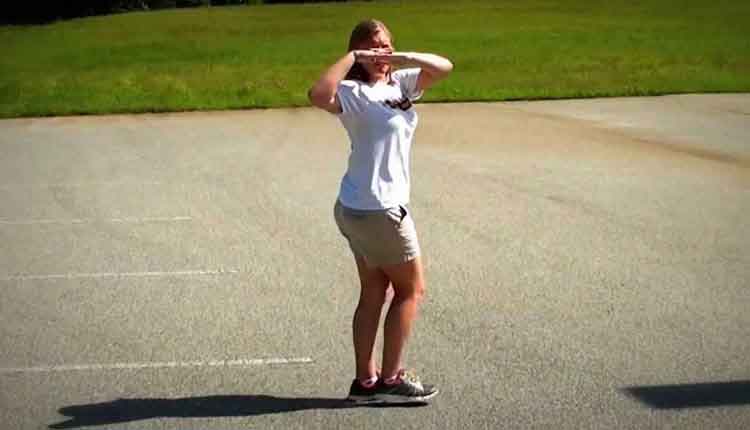Being a member of a marching band is difficult. Marching while playing an instrument takes concentration and determination. Marching an 8 to 5 step size isn’t easy, and fast tempos don’t make it any simpler. If you seem to be struggling with learning how to march, perhaps these steps will clarify the steps a bit.
Steps
- Stand at the proper attention position. It is very important to be uniform and exactly the same as other marchers of the same instrument.
- Pop your horn at the command. Make sure your that the motion is sharp, and if you miss it, do not, under any circumstances, move afterwards or you will be noticed.
- Take off on the appropriate count with your left foot. Usually this is half a count or a whole count before beat one when your foot will hit the ground.
- Pay attention to the exercise you are marching and halt or simply stop at the appropriate place and time, depending on the directions. If the directions involve a turn- i.e. “right/left/about face!”- and you miss it, do not turn late as this makes the band look sloppy. You should march to your location and fix yourself as soon as possible.
- Maintain proper body posture. Do not look at the ground and maintain a good focal point (usually the box if marching on a field.) Keep your head held high. Be proud! Square or point your body towards the appropriate position. Stand straight up and make sure to follow any guidelines involving holding your instrument. Example: Clarinets should have their elbows out in a triangle.
- March in time. Hit the ground on the downbeats. Your feet should cross on the offbeats.
Marching Forwards
- Plant the heel of your foot into the ground with your toes raised for your first step. If the words “Hi Mom!” were written on the soles of your shoes, people in the audience should be able to read them.
- Roll the rest of your foot down to the ground. Congratulations, you just took your first step.
- Repeat with the right foot and alternate.
- Keep your knees straightened out on the downbeats. This may vary for other marching techniques.
Marching Backwards
- Plant your platform of your left foot on your ground on your left step as if you are a ballerina.
- Move your right foot in the same manner.
- Refrain from letting your heels touch the ground until you halt.
- Keep knees straightened throughout. If you have very large steps you may bend your knees slightly. This may vary for other marching techniques.
Tips
- Try saying the words “check and” before marking-time and between each command. It keeps you from starting the command too soon.
- Make sure to keep each of your steps the same size.
- There are many step sizes, such as 8-5 (eight steps to five yards) and 16-5 (sixteen steps to five yards). You may have to adjust your step size to meet these requirements. For instance, if you are tall and have long legs, you will have to take smaller steps.
- Remember to roll your feet! Your instrument’s sound will be so much better.
- Make sure that you are in step with the beat that is being projected by the drum major. If you are off step, there are many methods you can use to get back in step: a slight skip for one step that will switch your legs quickly, but unfortunately, will cause you to jump up slightly; you can slow your steps down for a second until the quick pace of everyone else forces you back into step, easier to do, but this can cause you to look even more awkward while getting back in step; or you can do the most common and easiest method, which is to take smaller steps and speed them up. This is easier than the slowing down method because you just have to lengthen your stride again to get back with everyone else rather than speeding up again and taking smaller steps.
- The marching style also depends on the band you are in. Some bands encourage bending the knees, other do not. Also the marching drum-line that always faces the sideline may march with a style in which the legs cross while sliding (also called crab-walking.)
- Most importantly, dress the lines! When marching, be sure to always look at the persons in front and to the sides of you using your peripheral vision.
Warnings
- If you don’t roll your feet, the marching doesn’t look good and the playing is horrible. Also, not rolling your feet may cause you to actually trip when marching, and no one wants a domino effect to happen to a band.
- When marching backwards it is imperative that you stay on your toes. If you let your heels touch the ground it will be nigh impossible for you to be able to control your body weight at the next direction change. This also makes you much more likely to fall over backwards due to loss of balance or irregularities in the marching surface.
- Be careful not to “tight rope”; this means putting one foot directly in front of the other. It doesn’t look good and it will be much harder to march fast and execute direction changes that way. Some marching techniques however REQUIRE that you march one foot infront of the other, ask your band director or upperclassmen if you are unsure.
- There are many different marching techniques; what is considered good technique in one band may be considered horrible in another (i.e. bent and unbent knees). Since a band needs to look uniform to look impressive, drum major or band director instruction is always the authority on technique.


